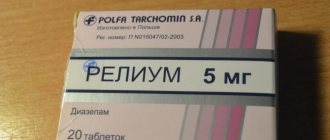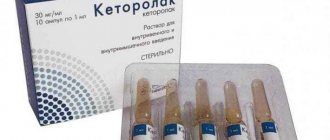Compound
active ingredients:
1 tablet contains piracetam in terms of 100% substance 200 mg; morpholinium salt of thiazotic acid in terms of 100% substance 50 mg, which is equivalent to 33.3 mg of thiazotic acid;
Excipients:
potato starch, povidone, powdered sugar, microcrystalline cellulose, calcium stearate, coating mixture “Opadry II Yellow” 33G22623 (contains lactose monohydrate; sunset yellow FCF (E 110)).
Dosage form.
Film-coated tablets.
Basic physical and chemical properties:
Tablets, coated, yellow, round in shape, with a biconvex surface; a white core is visible on the crack.
Pharmacotherapeutic group.
Medicines acting on the nervous system. Psychoanaleptics. Psychostimulants, drugs used for attention deficit hyperactivity disorder (ADHD) and nootropics. Other psychostimulants and nootropics. ATX code N06B X.
Release form and composition
Thiocetam is available in the following dosage forms:
- film-coated tablets: round, biconvex, yellow, with a white or almost white core visible at the break (10 pieces in blister packs; in a cardboard box there are 3 or 6 blister packs along with instructions for use of the drug);
- solution for intravenous and intramuscular administration: transparent, colorless or slightly yellowish (5 ml or 10 ml in colorless transparent glass ampoules; 5 ampoules in blister packs made of polyvinyl chloride, in a cardboard box 2 blister packs along with instructions and an ampoule scarifier ; 10 ampoules in a cardboard box with a corrugated liner, instructions for use of Thiocetam and an ampoule scarifier).
Composition per film-coated tablet:
- active ingredients: thiotriazoline (morpholinium methyl triazolyl thioacetate) – 50 mg, piracetam – 200 mg;
- auxiliary components: sucrose, low molecular weight povidone, calcium stearate, potato starch, microcrystalline cellulose;
- film shell composition: Opadry II yellow (hypromellose, macrogol, titanium dioxide, yellow iron oxide dye, aluminum varnish based on indigo carmine, lactose monohydrate, aluminum varnish based on sunset yellow dye, triacetin, aluminum varnish based on quinoline yellow).
Composition per milliliter of solution:
- active ingredients: thiotriazoline (morpholinium methyl triazolyl thioacetate) – 25 mg, piracetam – 100 mg;
- auxiliary components: water for injection.
Pharmacological properties
Pharmacodynamics.
The drug belongs to the group of cerebroactive drugs and has anti-ischemic, antioxidant, membrane-stabilizing and nootropic properties.
The drug improves the integrative and cognitive activity of the brain, helps to increase the efficiency of the learning process, helps eliminate the symptoms of amnesia, and increases short-term and long-term memory.
The pharmacological effect of the drug is due to the mutually potentiating effect of thiotriazoline and piracetam.
The drug is able to accelerate the oxidation of glucose in aerobic and anaerobic oxidation reactions, normalize bioenergetic processes, increase ATP levels, and stabilize metabolism in brain tissue.
The drug inhibits the formation of reactive oxygen species, reactivates the antioxidant enzyme system, especially superoxide dismutase, inhibits free radical processes in brain tissue during ischemia, improves the rheological properties of blood due to activation of the fibrinolytic system, stabilizes and reduces areas of necrosis and ischemia, respectively.
Pharmacokinetics.
It is well absorbed when administered orally and penetrates into various organs and tissues, including brain tissue. The drug penetrates the placental barrier. Each component of the drug is metabolized separately.
Piracetam is practically not metabolized in the body and is excreted in the urine. The half-life is 4–8 hours.
Morpholinium salt of thiazotic acid is rapidly absorbed after oral administration, its absolute bioavailability is 53%. The maximum concentration in blood plasma is achieved 1.6 hours after a single dose of 200 mg. The half-life is almost 8 hours.
Clinical characteristics.
Contraindications
Hypersensitivity to piracetam, pyrrolidone derivatives, thiazotic acid, as well as to any other component of the drug.
Acute cerebrovascular accident of hemorrhagic type.
Acute renal failure. End stage renal failure.
Huntington's chorea.
Interaction with other drugs and other types of interactions.
Thiocetam should not be prescribed with drugs that have an acidic pH.
Due to the presence of piracetam in the composition of the drug, interaction with the following drugs is possible:
Thyroid hormones.
When used together with thyroid hormones (T3+T4), increased irritability, disorientation and sleep disturbance are possible.
Acenocoumarol.
In patients with severe recurrent thrombosis, the use of piracetam in high doses (9.6 g / day) did not require a change in the dosage of acenocoumarol to achieve a prothrombin time (INR) value of 2.5–3.5, but with its simultaneous use there was a significant decrease in the level platelet aggregation, fibrinogen level, von Willebrand factors (VIII: C; VIII: vW: Ag; VIII: vW: Rco), blood and plasma viscosity.
Pharmacokinetic interactions.
The likelihood of changes in the pharmacodynamics of piracetam under the influence of other drugs is low, since 90% of the drug is excreted unchanged in the urine.
In vitro
piracetam does not suppress cytochrome P450 isoforms CYP1A2, 2B6, 2C8, 2C9, 2C19, 2D6, 2E1 and 4A9/11 at concentrations of 142, 426, 1422 μg/ml.
At a concentration of 1422 μg/ml, there is a slight inhibition of CYP2A6 (21%) and 3A4/5 (11%). However, the Ki level of these two CYP isomers is sufficient when exceeding 1422 μg/ml. Therefore, metabolic interaction with drugs that undergo biotransformation by these enzymes is unlikely.
Antiepileptic drugs.
The use of piracetam at a dose of 20 mg/day daily for 4 weeks or more did not change the concentration curve and maximum concentration (Cmax) of antiepileptic drugs in the blood serum (carbamazepine, phenytoin, phenobarbital, sodium valproate) in patients with epilepsy.
Concomitant use with enalapril and captopril increases the risk of adverse reactions from the cardiovascular system.
Alcohol.
Co-administration with alcohol did not affect the serum concentration of piracetam, and the concentration of alcohol in the blood serum did not change with the use of 1.6 g of piracetam.
Drug interactions Thiocetam
Thiocetam should not be prescribed with drugs that have an acidic reaction. Due to the presence of piracetam, the effect of antidepressants and antianginal drugs is enhanced. In high doses (9.6 g/day), piracetam increases the effectiveness of acenocoumarol in patients with venous thrombosis, but this effect was not observed when Thiocetam was used in therapeutic doses. There was no interaction between piracetam and clonazepam, phenobarbital, phenytoin, and sodium valproate. The simultaneous use of piracetam and thyroid hormones (T3 + T4) can cause irritability, disorientation, and sleep disturbance. The interaction of piracetam with drugs that undergo biotransformation by enzymes of the P450 complex is unlikely. Concomitant use with enalapril and captopril increases the risk of adverse reactions from the cardiovascular system. Co-administration with alcohol does not affect the level of piracetam concentration in the blood serum.
Application Features
The drug should be used with caution in elderly people with cardiovascular pathologies, since the above adverse reactions are observed more often in this group of patients.
Allergic reactions are more common in people prone to allergies.
Effect on platelet aggregation. Due to the fact that piracetam reduces platelet aggregation, it should be prescribed with caution to patients with impaired hemostasis, conditions that may be accompanied by hemorrhages (ulcers of the gastrointestinal tract), during major surgical operations (including dental interventions), patients with symptoms of severe bleeding and patients with a history of hemorrhagic stroke; patients who use anticoagulants, platelet antiplatelet agents, including low doses of acetylsalicylic acid. The drug is excreted by the kidneys, so special attention should be paid to patients with renal failure.
Elderly patients. During long-term therapy in elderly patients, regular monitoring of renal function parameters is recommended, and if necessary, adjust the dose depending on creatinine clearance.
The drug contains lactose as an excipient, which should be taken into account when used in patients with galactose intolerance, lactase deficiency or glucose/galactose malabsorption.
1 tablet of Thiocetam contains 3.5 mg of powdered sugar, which should be taken into account when prescribing to patients with diabetes.
Use during pregnancy or breastfeeding
. Do not apply.
The ability to influence the reaction rate when driving vehicles or other mechanisms.
The use of the drug when driving vehicles or working with mechanisms that require increased attention is not recommended due to the risk of developing undesirable reactions from the nervous system.
Special instructions for the use of the drug Thiocetam
The drug can be prescribed for cerebral circulatory insufficiency with speech, memory, attention disorders, decreased intellectual-mnestic function of the brain and emotional disturbances, to increase learning opportunities, as well as for cephalgia, including those caused by neurocirculatory dystonia. Thiocetam can be used to treat the listed diseases against the background of heart pathology (angina pectoris, myocardial infarction), liver (hepatitis, cirrhosis) and viral infections. Prescribe with caution to patients with chronic renal failure. The drug affects platelet aggregation, so it should be used with caution in patients with impaired hemostasis during surgical interventions. The drug should be used with caution in elderly people with cardiovascular pathology due to the fact that the above-mentioned adverse reactions are observed more often in this group of patients. Allergic reactions are more often detected in individuals predisposed to allergies. Use during pregnancy and lactation. There is no experience with the use of the drug during pregnancy or breastfeeding, so the drug is not used during this period. Children. There is no experience in using the drug to treat children, so it is contraindicated for use in children. The ability to influence reaction speed when driving vehicles or working with other mechanisms . The use of the drug when driving vehicles and working with mechanisms that require increased attention is not recommended due to the risk of developing possible adverse reactions from the nervous system.
Directions for use and doses
The duration of treatment is determined by the doctor in each individual case separately, depending on the course of the disease.
For transient and chronic cerebrovascular accidents and during the rehabilitation period after an ischemic stroke - 2 tablets 3 times a day for 25–30 days.
Take Thiocetam tablets 30 minutes before meals.
The course of treatment ranges from 2–3 weeks to 3–4 months.
For the treatment of diabetic encephalopathy, take 2 tablets 3 times a day for 45 days.
Children.
Do not apply.
Indications for use of the drug Thiocetam
Tablets : transient and chronic disorders of cerebral circulation caused by atherosclerosis of cerebral vessels; disorders of metabolic processes in the brain caused by traumatic brain injury, intoxication, diabetic encephalopathy, as well as during the rehabilitation period after ischemic and hemorrhagic stroke. Injection solution: treatment of ischemic stroke (in the subacute and recovery period) and its consequences such as speech impairment, mental and somatic disorders, decreased activity, emotional disturbances; treatment of vascular, toxic, traumatic and diabetic encephalopathy; elimination of withdrawal syndrome due to alcohol intoxication.
Overdose
Symptoms.
When used in therapeutic doses, overdose is impossible.
If the doses prescribed by the doctor are exceeded, side effects of the drug may occur and intensify (excitement, sleep disturbance, dyspeptic symptoms). In case of overdose, the concentration of sodium and potassium in the urine increases.
Treatment.
The drug must be discontinued and symptomatic treatment prescribed (induce vomiting, rinse the stomach). There is no specific antidote; hemodialysis can be used (removal of 50–60% of piracetam).
Drug interactions
Thiocetam should not be used simultaneously with drugs that have an acidic pH value.
Piracetam enhances the effect of antianginal drugs and antidepressants. When combined with thyroid hormones, sleep disturbances, irritability and confusion may occur. Metabolic interaction of piracetam with other drugs is unlikely.
Alcohol does not affect the serum concentration of piracetam; Serum ethanol concentration also remained unchanged after taking 1.6 g of piracetam.
There is no data on the compatibility of Thiocetam in solution form with other agents for parenteral administration.
Side effects
During the clinical use of the drug Thiocetam, adverse reactions may occur:
from the central and peripheral nervous system:
headache, general weakness, insomnia, drowsiness, anxiety, internal tension;
from the gastrointestinal tract:
nausea, vomiting, dry mouth, diarrhea;
from the immune system, skin and subcutaneous tissue:
allergic reactions, including rashes, itching, hives, sweating;
from the vestibular system:
dizziness.
Patients may develop adverse reactions caused by individual components of the drug:
- piracetam:
from the blood and lymph:
hemorrhagic disorders;
from the immune system:
hypersensitivity, anaphylactoid reactions;
mental disorders:
nervousness, depression, increased excitability, anxiety, agitation, hallucinations;
from the nervous system:
hyperkinesia, drowsiness, ataxia, imbalance, increased frequency of epilepsy attacks, headache, insomnia, tremor;
from the organs of hearing and labyrinth:
dizziness;
from the digestive system:
abdominal pain, pain in the upper abdomen, diarrhea, nausea, vomiting;
from the skin and subcutaneous tissues:
angioedema, dermatitis, rashes, urticaria, itching;
from the reproductive system:
increased sexual activity;
general disorders:
asthenia, weight gain;
- thiazotic acid:
from the skin and subcutaneous tissue:
itching, skin hyperemia, rashes, urticaria, angioedema;
from the immune system:
anaphylactic shock;
from the central and peripheral nervous system:
dizziness, tinnitus;
from the cardiovascular system:
tachycardia, increased blood pressure;
from the gastrointestinal tract:
dyspepsia, including dry mouth, bloating, nausea, vomiting;
from the respiratory system:
shortness of breath, suffocation;
general disorders:
fever, general weakness.
The drug contains the dye sunset yellow FCF (E 110), which may cause allergic reactions.
Side effects
- gastrointestinal tract: vomiting, dry mouth, nausea, bloating and abdominal pain, diarrhea;
- cardiovascular system: arrhythmias, tachycardia, pain in the heart area, hypertension, exacerbation of coronary insufficiency (in elderly patients);
- respiratory system: attacks of suffocation, shortness of breath;
- nervous system: tinnitus, headache, drowsiness or insomnia, dizziness, irritability, mental agitation, ataxia, motor disinhibition, anxiety, asthenic state, depression, hallucinations, imbalance, confusion, exacerbation of epilepsy;
- sense organs: vertigo;
- metabolism: increased body weight;
- allergic reactions: skin itching, dermatitis, urticaria, hypersensitivity, Quincke's edema, fever;
- reactions at the injection site: pain at the injection site.








